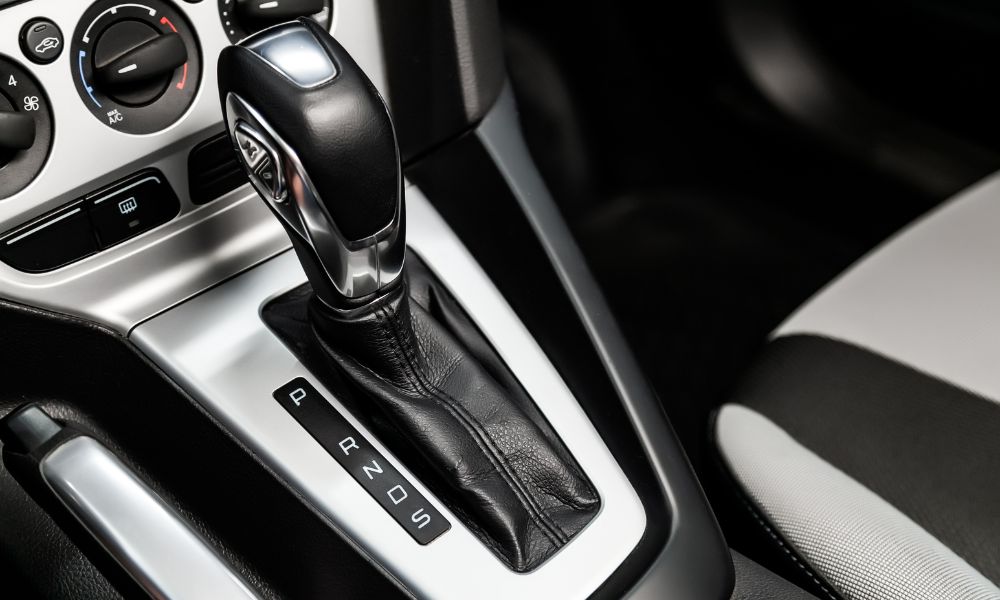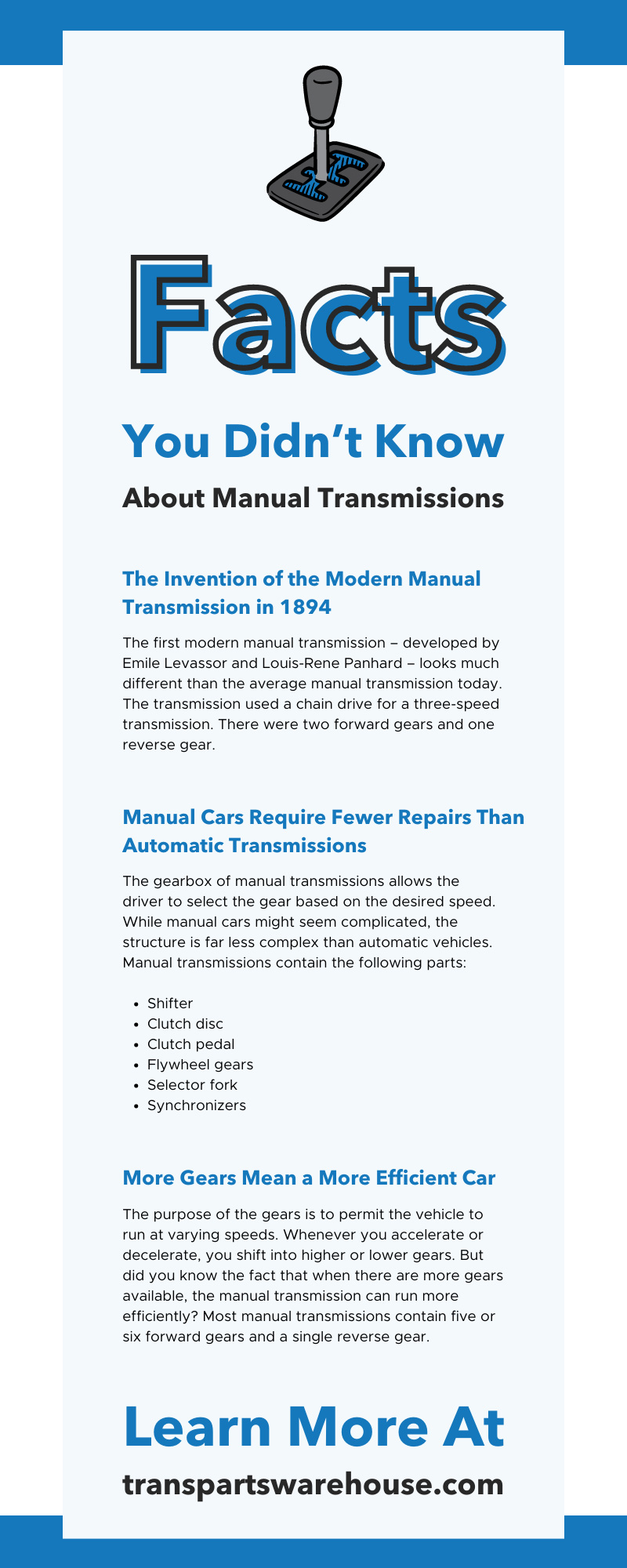
Manual cars are gradually becoming a thing of the past. If you’re an automotive enthusiast or want to learn more about the art of these mesmerizing vehicles, read on to find out eight facts about manual transmissions that you didn’t know before!
The Invention of the Modern Manual Transmission in 1894
The first modern manual transmission – developed by Emile Levassor and Louis-Rene Panhard – looks much different than the average manual transmission today. The transmission used a chain drive for a three-speed transmission. There were two forward gears and one reverse gear.
Driving this way during the early stages of cars was quite taxing. Nevertheless, this monumental moment acted as the starting point for each subsequent model.
Manual Cars Require Fewer Repairs Than Automatic Transmissions
The gearbox of manual transmissions allows the driver to select the gear based on the desired speed. While manual cars might seem complicated, the structure is far less complex than automatic vehicles. Manual transmissions contain the following parts:
- Shifter
- Clutch disc
- Clutch pedal
- Flywheel gears
- Selector fork
- Synchronizers
Although this may seem like a lengthy list, manual cars are less likely to contain parts that break down entirely. Instead, when the time comes that you need manual transmission replacement parts, the repair will extend the car’s lifespan without costing a fortune.
Automatic vehicles endure frequent transmission breakdowns that require higher-price replacements. When you regularly service your manual car, you won’t experience many maintenance complications!
More Gears Mean a More Efficient Car
The purpose of the gears is to permit the vehicle to run at varying speeds. Whenever you accelerate or decelerate, you shift into higher or lower gears. But did you know the fact that when there are more gears available, the manual transmission can run more efficiently?
Most manual transmissions contain five or six forward gears and a single reverse gear. Six speeds are perfect for dynamic driving at over 100 miles per hour. However, the average manual transmission uses five-speed gears to reach 65 miles per hour and above.
Nevertheless, speed isn’t the only feature car lovers look for in manual vehicles. They want efficiency. Fewer available gears make it very challenging to achieve higher speeds and switch gears quickly. If you’re looking to optimize fuel efficiency in a four-or three-speed vehicle, it’s improbable.
That’s why five or six gears are great for manual cars. It gives the gears more power to skillfully secure the proper gear and shift easily as needed.
Manual Vehicles Are Great for Tough Road Conditions
After mastering the skill of driving a manual car, you can fully control the movement. This will come in handy whenever bad weather or poor road conditions arise.
Hydroplaning on rainy roads when driving an automatic car means you must lower your speed, but you can’t slam on the brakes. Instead, it’s a gradual process that might leave you unable to gain control over the car.
Manual transmissions provide more control. You can eliminate the jerky movements by sticking in the lower gears. If the tires begin to lose traction, ease off the pedal and downshift to a lower gear. This method is much safer and more effective than using automatic vehicles.
Another perk of manual transmissions is that they’re good for handling tricky roads. As you manage the shifting gears in a manual transmission car, the vehicle easily adheres to the hills and curves. Heightened control achieves a safer drive no matter the conditions.
Manual Transmissions Have a Lifespan of Up to 120,000 Miles
As always, the lifespan of the transmission of any car depends on the regularity of maintenance, driving conditions, quality of the fluids, and the condition of the clutch.
Manual transmissions typically last from 100,000 to 120,000 miles. In comparison, automatic transmissions can start experiencing issues as early as 100,000 miles while most likely dying out around 200,000 miles.
Replacing the clutch is a critical component that can alter the transmission’s lifespan. The clutch can last anywhere from 20,000 to 150,000 miles. Nevertheless, the parts will make it clear when an issue occurs. With the proper care for the clutch and high-quality fluids to manage the engine and transmission, you’re likely to have a long-lasting manual vehicle.
A Manual Car Is Less Likely To Get Stolen
As the art of driving manual vehicles dwindles, fewer people possess the skills to drive them. Car thefts are on the rise. Whether you park outside in your driveway or park downtown in a busy city, your vehicle could be at risk.
However, if you drive a manual car, you might be in luck. Since fewer people know how to drive manual cars, the vehicle is now more challenging to steal. You could lose a few belongings from the break-in, but there’s less of a risk of your car disappearing into the night by a stranger.
Take Manual Vehicles Autocrossing
Manual cars aren’t just great for navigating challenging terrain or saving money on repairs. They’re also incredibly fun to drive for sport.
Autocross is a form of racing where drivers maneuver around obstacles like cones or pylons at high speeds. Rapidly braking paired with the need to instantly shift into a higher gear makes manual cars perfect for this style of race.
You Can Buy New Cars With Manual Transmissions
In an automatic transmission world, you hardly see any manual vehicles on the market. As a manual transmission enthusiast, you want to find something extravagant and new.
There’s no need to scour the Internet to find an old, rusty manual car that you must fix up. You can savor the thrill of purchasing something new instead.
Car manufacturers continue to make vehicles, including manual transmissions. You can use these cars for everyday drives or take them out to a sports track to test the speed. Some of the modern manual vehicles available to choose from include:
- BMW M4
- Cadillac CT5-V Blackwing
- Chevy Camaro
- Chevy Spark
- Dodge Challenger
- Kia Forte
- Kia Rio 5-door
- Mazda MX-5 Miata
Never let your love for manual transmissions fade. Find an older model to fix up, a modern vehicle to enhance the thrill of everyday drives, or a manual car to support your autocross endeavors. Whatever the purpose is for your manual car, you’re sure to love the incredibly unique benefits.


